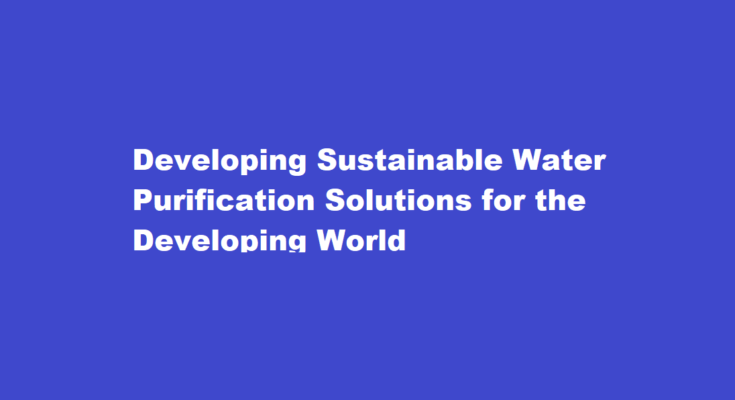Introduction
Access to clean and safe drinking water is a fundamental human right, yet millions of people in developing countries lack access to potable water, leading to numerous waterborne diseases and health challenges. To address this pressing issue, it is imperative to create cost-effective, scalable, and innovative water purification systems tailored to the unique needs of developing nations. This article explores the key factors and strategies required to develop sustainable water purification solutions that can make a meaningful impact in improving the lives of millions.
Understanding Local Water Contamination
To design an effective water purification system, it is crucial to comprehend the specific contaminants present in the water sources of the target region. Different areas face diverse water pollution challenges, such as bacterial contamination, heavy metals, chemical pollutants, or excess minerals. Conducting thorough water quality assessments and collaborating with local authorities and communities can help identify the primary contaminants and tailor the purification system accordingly.
Leveraging Appropriate Technologies
Innovation is the cornerstone of any successful water purification system. For developing countries, it is essential to focus on affordable and simple technologies that can be easily maintained and operated by local communities. Some proven technologies include
a. Filtration Systems – Utilizing low-cost filtration methods like ceramic filters, biosand filters, or mesh screens can effectively remove particulate matter and bacteria from water sources.
b. Chlorination – Adding chlorine in the form of liquid bleach or chlorine tablets can disinfect water and eliminate harmful pathogens.
c. UV Disinfection – Ultraviolet (UV) treatment can be an eco-friendly and cost-effective method to purify water without using chemicals.
d. Solar-Powered Solutions – Harnessing solar energy for water purification can significantly reduce operational costs and make the system more sustainable.
Modular and Scalable Design
Creating a scalable water purification system is essential to accommodate varying water demands and expand the solution to cover a larger population. Implementing a modular design allows for flexibility in system size, enabling easy adjustments to meet the changing needs of communities as they grow. Moreover, a modular approach facilitates streamlined maintenance and upgrades.
Community Involvement and Training
Successful water purification projects require active involvement from the local communities. Engaging stakeholders, conducting workshops, and providing training on system operation and maintenance empowers communities to take ownership of the purification process. When the beneficiaries are educated about the importance of clean water and how to use and maintain the purification system, it ensures the project’s sustainability and long-term success.
Emphasizing Sustainability
A truly effective solution must be sustainable in the long run. To achieve this, the project should focus on local capacity-building and resource mobilization. This could include collaborating with local organizations, governments, or NGOs to secure funding, as well as empowering local technicians to maintain and repair the purification systems independently.
Monitoring and Evaluation
Continuous monitoring and evaluation are essential to assess the system’s effectiveness and identify areas for improvement. Implementing water quality testing and community health surveys can provide valuable insights into the impact of the water purification project. Data-driven decision-making helps optimize the system’s performance and ensures that the water provided remains safe and potable.
FREQUENTLY ASKED QUESTIONS
What is a cost effective way to purify water?
Boiling water is the cheapest and safest method of water purification. Water sources and or channels of distribution may render your water unsafe. For example, parasites and germs are things you may not see by bare eyes, but their effects can be life threatening.
How are water treatment technologies used in developing countries and which are the most effective?
Most of the time, ultrafiltration will be the right choice for water filtration systems for developing countries. However, the decision on which technology to use will depend on what harmful substances are in the local water and on the needs of the community.
Conclusion
Developing cost-effective, scalable, and innovative water purification systems for developing countries is a challenging yet vital endeavor. By understanding local water contamination, leveraging appropriate technologies, focusing on sustainability, and actively involving the communities, we can make a significant difference in improving access to clean and safe drinking water for millions of people. The journey towards a healthier, more equitable world begins with empowering the most vulnerable with the most basic necessity of life – clean water.
Read Also : Embracing Local Roots A Guide to Organizing a Community-Driven Festival Celebrating Culture and Traditions



